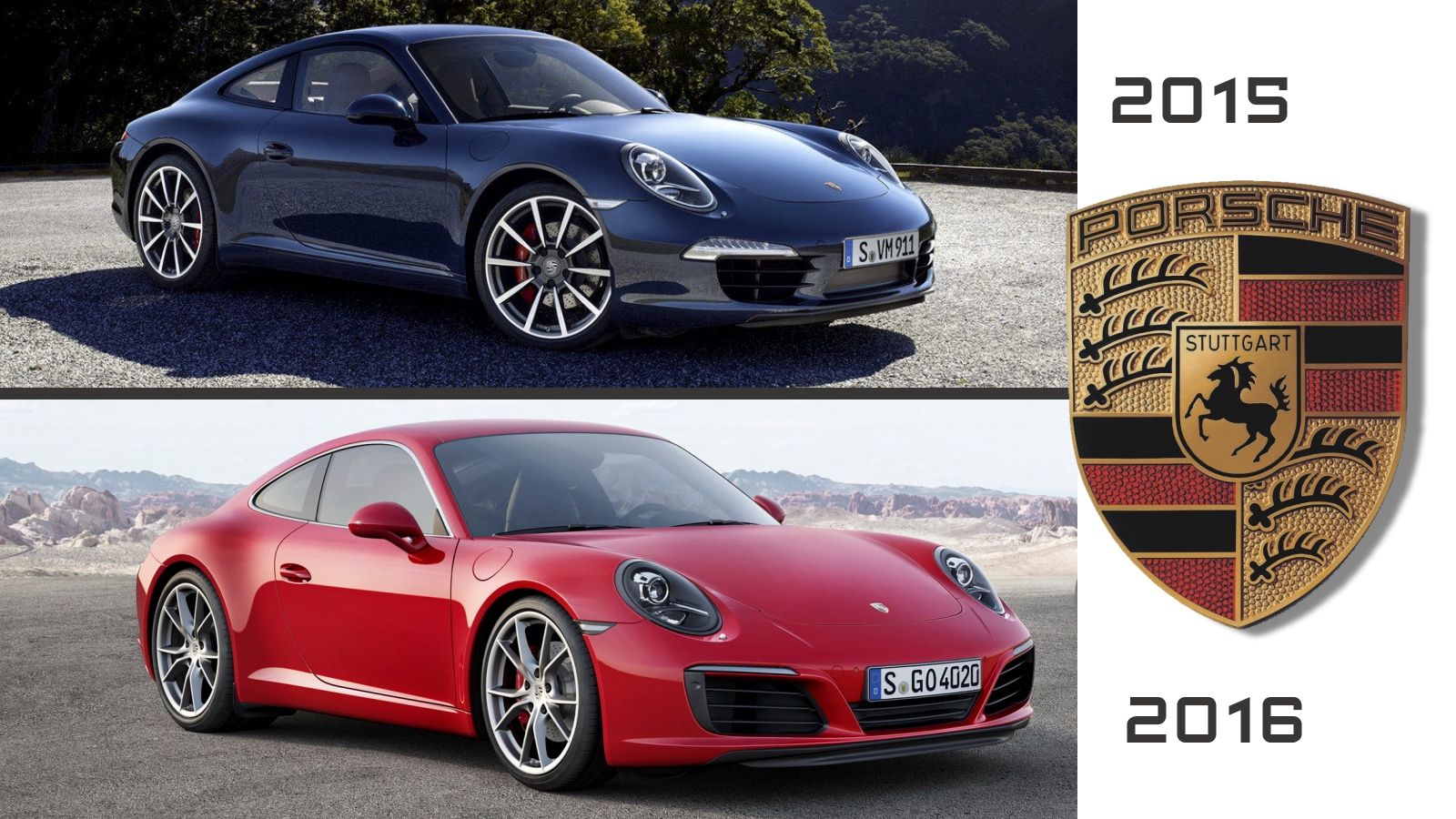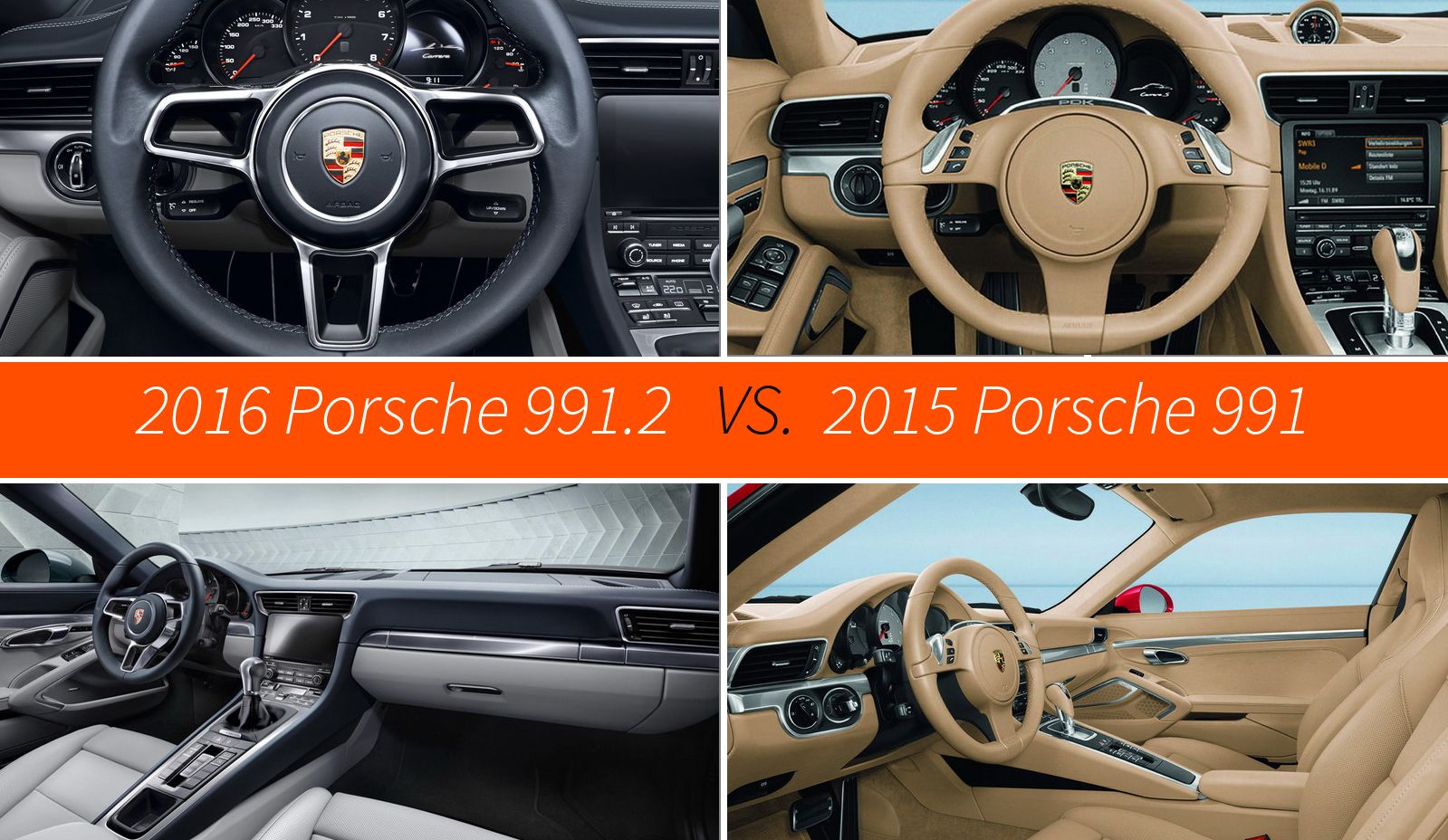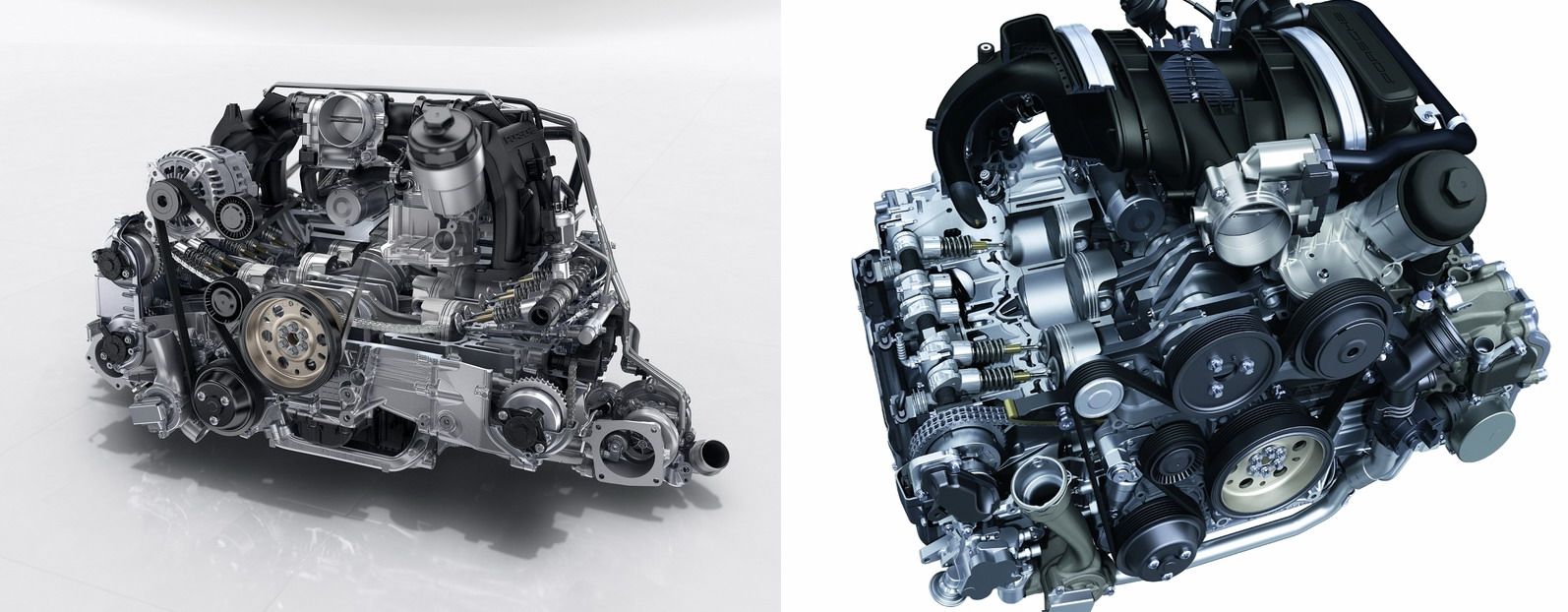It's been four years since its introduction at the 2011 Frankfurt Motor Show->ke235, and the 2012 Porsche 911 (991) has just received it mid-cycle facelift. Much like all 911 facelifts from 1990 onward, this update brings small, evolutionary changes to the sports car's->ke506 appearance, and new convenience features and tech on the inside. However, the 991.2, as Porsche->ke1 officially calls this facelift, is a whole different car under the hood, which isn't exactly ordinary considering Stuttgart's take on previous mid-cycle updates.
And I'm not talking about increased outputs or different displacements for the engines. Nope, this time around Porsche stripped the 911 Carrera->ke282 of of its naturally aspirated units and planted a turbocharged mill between the rear wheels -- a change that's almost as big as going from air-cooling to water-cooling, which happened in 1998 and caused quite a commotion among 911 purists. But most of us got over it.
The new switch is already a subject of controversy, with fanatics sobbing over the death of the all-motor Carrera, and turbo fans cheering over having the option to purchase force-fed 911s without having to pay those expensive stickers that come with the Turbo and the Turbo S->ke571.
Because the 991.2 is such a big deal compared to its predecessor, I decided to have a closer look at what sets the two versions of 991-generation 911 apart.
Continue reading for the full story.
Exterior
As with most 911 facelifts, the 991.2 is mostly about the little details. Though the current 911 was far from dated in terms of design (what 911 is anyway?), a mild refresh was performed to keep the sports car in line with today's trends. You know, anything older than three or four years is... well... old in the current market, but a few nips and tucks will magically turn it into a fresh product.
Irony aside, upon close inspection, the 991.2's exterior has quite a few new details.
Up front, the most notable change lies in the bumper. Though the three-piece intake configuration was carried over from the previous model, the actual openings are different in shape and size. The main intakes extend farther toward the sides and feature three horizontal slats instead of two. Also, the LED light strips above are significantly slimmer and completely integrated into the frame surrounding the openings.
The center piece seems to be about the same size, but it now features two horizontal slats instead of one and the trapezoidal shape defining it has been turned upside down. Down below, there's a slightly larger splitter, which in conjunction with the Cayman GT4-like bumper, makes the new 911 seem a bit more aggressive. The headlamps have also been revised, now featuring four-point daytime running lights.
For my part, I like the previous bumper better. Then again, I think the 964->ke740 is the best looking 911 ever, which I guess makes me an old fart when it comes to styling. All told, beauty is in the eye of the beholder and in the wallets of those who can afford a new 911...
Exterior Dimensions
|
Porsche 991 |
Porsche 991.2 |
|
|
Height |
51.30 Inches |
50.9 Inches |
|
Width |
71.18 Inches |
71.2 Inches |
|
Wheelbase |
96.46 Inches |
96.5 Inches |
|
Length |
176.81 Inches |
177.1 Inches |
Side-by-side comparison
Around back, we can identify two important changes. First up is the engine lid's grille, which ditched the previous design with horizontal louvers for a new configuration with vertical ones. The revised grille adds a touch of 1963-1964 Porsche 911 (901) to the 991, as it is very similar to the original 911's rear deck lid. To me, this is the 992.1's coolest feature in the exterior design. Second, the bumper received extra air outlets on each side, a feature borrowed from the Turbo models. Although they're smaller than on the Turbo, they do play an important part in cooling the new turbocharged engine. Other details that set the 991.2 apart from the outgoing model are the longer lights in the bumper and the slightly reshaped taillights, now looking a bit sleeker and featuring small dents toward the rear deck. They also include four-point brake lights.
When viewed from the side, the 991.2 can easily be mistaken for a 991. That's because the updated car only received door handles without recess covers and revised five-spoke wheels. The car does sit 0.4 inch lower, but that's not exactly noticeable. Same goes for the half-inch wider rear rims.
Speaking of dimensions, the 991.2 is actually longer and wider than its predecessor, but it's not like you're going to notice it given we're talking about less than two tenths of an inch for both numbers. It's the height that's more significant, as Porsche lowered it by nearly half an inch.
Interior
The 991.2's interior is pretty much identical to the outgoing model, with the main highlight being the new steering wheel. Based on the 2014 Porsche 918 Spyder's, the three-spoke steering wheel looks and feels sportier, featuring improved grip sections and aluminum center inserts. When the Carrera is equipped with the optional Sport Chrono Package, it receives a mode switch derived from the hybrid map switch of the 918 Spyder. The new feature consists of a rotary dial with four positions for the driving modes, including Normal, Sport, Sport Plus, and Individual. Also, models fitted with the PDK transmission come with a Sport Response button that sets the drivetrain for maximum acceleration.
More updates are to be found in the technology department. There's a new Porsche Communication Management (PCM) system (with an online navigation module) that can be operated by multi-touch gestures on the upgraded 7-inch display. It includes an expanded range of functions and simplified operation, Wi-Fi connectivity for smartphones, and Apple CarPlay for iPhones. For the first time, the 911 received Google Earth and Google Streetview besides real-time traffic information.
Side-by-side comparison
Drivetrain
This is where the 991.2 is revolutionary rather than evolutionary. To address increasingly tougher fuel economy and CO2 emissions rules in Europe, Porsche decided to replace both the naturally aspirated 3.4- and 3.8-liter flat six engines of the Carrera and Carrera S, respectively, with a twin-turbocharged, 3.0-liter unit. The change makes the 991.2 the first-ever Carrera to use forced induction as well as the first base 911 to not feature a naturally aspirated engine.
Specifically developed for this model, the new turbo-six enhances the Carrera's output by 20 horses and 43 pound-feet of torque. The base model now comes with 370 horsepower and 331 pound-feet of torque on tap, while the Carrera S is motivated by 420 horses and 368 pound-feet of twist.
Naturally, the updated output also makes the 911 Carrera quicker than its forerunner.
When equipped with the standard seven-speed manual transmission, the Carrera needs 4.4 seconds to hit 60 mph from a standing start and reaches a top speed of 183 mph. When ordered with the PDK transmission, the 0-to-60 mph sprint drops to 4.2 seconds, while the Sport Chrono package takes it down to an impressive four seconds flat. Top speed comes in at 182 mph in this configuration. The Carrera S is even quicker at 4.1 seconds and top speed at 191 mph, figures which are available with the manual transmission. Customers who choose the PDK over the stick will be able to experience 60 mph in 3.9 seconds or 3.7 ticks with Sport Chrono. For this model top speed is set at 190 mph.
On top of being quicker and more powerful, the new Carrera is also significantly more fuel efficient and greener, a couple of benefits that also come with turbocharging. Though specifics aren't yet available, Porsche claims the new engine is "almost twelve percent more efficient" compared to the previous model "according to the new European Drive Cycle." Given the outgoing model was good for up to 23 mpg combined with the PDK, I expect the facelifted sports car to offer 25 mpg combined. Also, depending on configuration, the 991.2 could return up to 30 mpg on the highway.
But that's not all. Along with being the first Carrera to feature turbocharging, the 991.2 is also the first Carrera to employ rear-axle steering. However, the system borrowed from the 2014 Porsche 911 Turbo and 2014 Porsche 911 GT3 is only available as an option. The system makes the Carrera more precise when changing lanes at higher speeds and delivers greater maneuverability in city traffic, thanks to a turning radius that is 1.6 feet smaller compared to models not using rear-axle steering. Also, the tech will also make it significantly quicker at the race track. According to Stuttgart, the new Carrera S with rear-axle steering lapped the Nurburgring Nordschleife->ke999 in seven minutes and 30 seconds, making it ten seconds faster than the previous model. In short, it's the fastest Carrera ever!
In the suspension department, the 991.2 got a reconfigured Porsche Active Suspension Management (PASM) system that offers improved driver control during fast cornering. A set of revised shock absorbers enhance comfort, while the updated tires have better grip and reduced rolling resistance. Porsche also offers an optional electro-hydraulic lift system that lifts the front axle by 1.57 inches at the push of a button, enabling the 911 to handle speed bumps or steep driveways.
Drivetrain Specifications
|
Model |
911 Carrera (991) |
911 Carrera (991.2) |
|
Cylinder layout / number of cylinders |
horizontally opposed 6 cylinder |
Boxer 6 |
|
Displacement |
3.4 l |
3.0 l |
|
Engine layout |
Rear engine |
Rear engine |
|
Max. Power |
350 HP |
370 HP |
|
Max. Torque |
287 LB-FT |
331 LB-FT |
|
Top Track Speed |
179 mph manual (178 mph PDK) |
183 mph manual (182 mph PDK) |
|
Acceleration 0 - 60 mph |
4.6 sec manual (4.4 sec PDK) |
4.4 sec manual (4.2 sec PDK) |
|
Model |
911 Carrera S (991) |
911 Carrera S (991.2) |
|
Cylinder layout / number of cylinders |
horizontally opposed 6 cylinder |
Boxer 6 |
|
Displacement |
3.8 l |
3.0 l |
|
Engine layout |
Rear engine |
Rear engine |
|
Cylinder layout / number of cylinders |
400 HP |
420 HP |
|
Displacement |
325 LB-FT |
378 LB-FT |
|
Top Track Speed |
188 mph manual (187 mph PDK) |
191 mph manual (190 mph PDK) |
|
Acceleration 0 - 60 mph |
4.3 sec manual (4.1 sec PDK) |
4.1 sec (3.9 sec PDK) |
Prices
Though facelifts usually don't come with hefty premiums, the new turbo engine makes the base 911 Carrera $5,100 more expensive than its predecessor. It is priced from $89,400 with a manual transmission and from $92,600 with the PDK. The Carrera S now reached into $100K territory with its $103,400 sticker with a manual and $106,600 with the quick-shifting automatic. As for cabriolets, the Carrera retails from $101,700 and the Carrera S fetches $115,700 before options.
Conclusion
From a design standpoint, picking between the 991 and 991.2 is only a matter of taste. Visual updates are mild, and although the 991.2 is a tad more aggressive thanks to its new bumper, some may still prefer the pre-facelift model. Including me. But when performance figures are taken into account, the 991.2 is the clear winner. It's significantly quicker and more powerful, not to mention that its Nurburgring lap in Carrera S specifications and with rear-axle steering sounds pretty impressive.
On the other hand, the lack of a naturally aspirated engine will probably upset a lot of purists, who'd rather have the responsiveness and exhilarating growl of an all-motor over the turbo's extra torque and improved fuel economy. Unfortunately, Porsche chose to sacrifice some of the Carrera's heritage in order to prepare the 911, as well as its entire vehicle lineup, for the tougher fuel economy and CO2 emissions rules that are about to come into effect in Europe. Whether we like it or not, turbocharging is the future, and Porsche is already aware of that.



